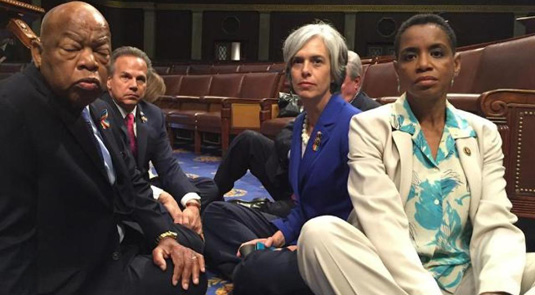
I was on Twitter on Wednesday morning, June 22, when I saw People’s World correspondent and fellow Twitter user Chauncey Robinson tweet the most tantalizing heads up I’ve ever read over my first cup of coffee:
#LRT: What’s happening on the House floor right now is pretty awesome and needed. #news #guncontrol #gunlaws #politics
The “Conscience of the Congress,” civil rights hero Rep. John Lewis, had delivered a moving and mic-dropping speech on the inability of Congress to act on any bill dealing with gun control in the face of the Orlando massacre, where 49 people were brutally gunned-down in the worst single-shooter mass killing in modern history.
And after that speech, the Representatives sat down and refused to move.
The GOP House leadership countered by simply shutting off the cameras to CSPAN, the usual feed displaying the actions of government to the public. Communications went dark.
Then, I saw a couple of tweets by late-night satirist Samantha Bee, from her show Full Frontal’s Twitter account:
Full Frontal @FullFrontalSamB Jun 22
.@ScottPetersSD We love what you’re doing. Could you please hand the phone to someone under thirty? #NoBillNoBreak
.@ScottPetersSD Haha but for real though… we want to watch.
I checked out the hashtag #NoBillNoBreak, and discovered what several other people were also about to discover: Rep. Scott Peters had downloaded the video application Periscope onto his cellphone on the advice of one of his staffers and was taking his maiden voyage in a historical first: the first Member of Congress to ever live-stream the occupation of the House floor by himself and his colleagues.
CSPAN, a normally bland outlet that simply broadcasts the routine workings of our government, was also unflappable in the face of a now minor obstacle of GOP censorship: they broadcast the feed from Rep. Peters’ phone videos. And, as more Members of Congress deployed their phones to record video via Periscope and Facebook Live, the media and the public watched in jaw-dropped amazement as the most unusual 25 hours in Congressional history unfolded.
My phone fired off notifications from Facebook and Periscope about every five minutes, signal flares from a body of people angered by a crisis of GOP gridlock and apathy: House Democrats testified passionately about the devastating violence and destruction of gun violence in their communities and on their own lives. Millions watched. Social media users, political junkies, celebrities, and opinion leaders tweeted and re-tweeted commentary the whole day and into the night.
Hundreds of people drove to D.C. to stand outside the House to show support. My own union, the American Federation of Teachers, turned out members to join the crowds- a searing reminder of the deep wounds of school shootings and children lost to gun violence. I wanted to be there too.
Representatives rushed in from meetings and distant locations to join their colleagues. Senators got word of the action and arrived in solidarity, some bearing snacks and beverages. Since I couldn’t be there, I looked for sign of my own Rep. , Jackie Speier, only to discover from her Facebook page that she was understandably at the side of her brother who was awaiting cancer surgery. That night however, she boarded a red-eye flight to Washington to give her own testimony, stopping at home first for an artifact that she had never shown in public.
In 1978, as a young Congressional aide to Rep. Leo J. Ryan of my family’s district, she had flown with a delegation to investigate growing concerns over a settlement called Jonestown, in Guyana, which had originated in California around the charismatic leader Jim Jones, before moving to South America. The Congressional delegation had underestimated the ugly paranoia that had reached a tipping point in Jones and his deputies, and were surprised by armed men in trucks from the encampment on the tarmac as they were preparing to return home.
Jackie Speier was shot along with Rep. Ryan, managing to live with 5 bullets in her body for 24 hours while lying next to the body of the assassinated Congressman.
In the House, Speier raised up a glassine bag. It contained a dumdum bullet. It was one of the bullets that had eventually worked its way to the surface of her body after the shooting, “Five bullets ripped through my body. I can’t begin to tell you what that is like. I can tell you what it’s like to live with a disfigured body the rest of your life. I can tell you that this dumdum and my disfigured body are things that remind me each and every day why what do here now is so important.”
Later that night on Chris Hayes’ news show, All In, Speier said that the action of herself and her colleagues reflected the public desire for action, and that the Orlando massacre and the cruel “business as usual” reaction from Congress represented a tipping point and a call to action.
Congress reconvenes after the July 4th holiday, with the potential to face a new terrain. Various pundits on the left, right, and center have assessed the promise and drawbacks of the proposed bills, the meaning of the action, and whether this action really signified a sea change in politics.
The continuing engagement of the mass movement is reflected in this action of Congressional disruption- as representatives begin to recognize enough support from their constituents to take such a bold action.
Gun control reform now has mass bipartisan support in a multi-class, multi-racial coalition, encompassing the grassroots, unions, and a majority of regular folks from both Democrats and Republicans-as well as the will of an activated Democratic congress manifesting the support of this coalition, going so far as to stage the unexpected improvisational protest of a usually powerless Congressional minority.
A broad coalition of this kind can be the wedge to be driven into right-wing obstructionism. Let’s not allow this opportunity be overshadowed by cynicism, instead let’s take advantage of the dynamic opportunity presented.
Photo: video snapshot









